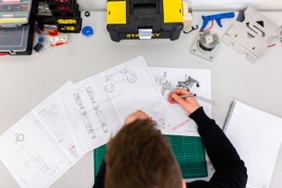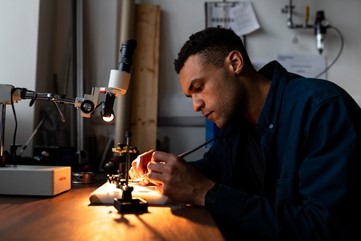Matthew Aladesaye is a PhD qualified Mechanical Engineer from Massey University, Auckland, New Zealand with experience across many facets, including managing a team of engineers who provide condition monitoring and reliability services to different industries. In the following article, Matthew Aladesaye discusses how the creativity of mechanical engineers touches every aspect of our lives, what they do, and why our future lies in their hands.
For many people, the word “creativity” immediately calls to mind an artist of some description—a painter, a dancer, an actor, perhaps… But what about an engineer? Isn’t engineering about math and science? But how could a profession so math-heavy be creative?
Mechanical engineers work to improve quality, efficiency, and sustainability in every aspect of human life. As a field, mechanical engineering combines the principles of math and science with innovation and creativity to solve problems with the goal of enhancing human quality of life.
Matthew Aladesaye Explains the Basis of Mechanical Engineering
When people think of mechanical engineering, they tend to picture big machines like cars, trains, forklifts and conveyor belts. And fair enough—mechanical engineers are behind each of these inventions! But this list barely scratches the surface of what they do.
At its core, mechanical engineering is a form of applied problem-solving. From nanotechnology involving computer chips to satellite designs, mechanical engineers (quite literally!) work on projects of all shapes and sizes.
Matthew Aladesaye says that by this definition, mechanical engineering has been around since the first civilizations began developing simple tools, like the wheel, which made transportation easier, the levers and pulleys involved in ancient construction projects and the irrigation systems required to grow enough food to support the growth of early societies.
The Industrial Revolution marked an important turning point in the history of mechanical engineering. Newly equipped with steam engines and mass-produced iron, mechanical engineers began manufacturing machines and steam-powered transportation.
Matthew Aladesaye also notes that during the 20th century, exciting new fields emerged, including aerospace technology, nuclear energy, robotics and biomechanics, to name a few.
Today’s mechanical engineers may use more advanced tools and more complex mathematical and scientific reasoning, but their ultimate goal remains the same, namely, to meet the needs of ever-developing human demands.
What These Engineers Do
Matthew Aladesaye explains that mechanical engineering is one of the broadest among the many fields of engineering. Not only does mechanical engineering touch every aspect of our lives, working in the field can involve everything from researching to designing to developing to assembling to testing to maintenance.
In the manufacturing sector, these engineers can have a hand in producing everything from food products to cell phones. Whether designing the product, its packaging or the machine used to assemble it, mechanical engineers play a vital role in producing the things we depend on to survive.
Matthew Aladesaye also says that mechanical engineers who work in construction help to design and create amenities such as heating and air conditioning systems, as well as the practical technologies involved in creating multistory buildings, such as elevators.
As this timeline of mechanical engineering history shows, transportation has also always been a major focus of the field of work. From the creation of the earliest horse-drawn carts to the present, mechanical engineering techniques have enabled humans to build a global economy, explore what lies beneath the earth’s surface, study the depths of the ocean and launch ourselves into the sky and onto the moon.
Matthew Aladesaye reports that with the development of pacemakers, artificial limbs and surgical machinery, the biomedical sector of mechanical engineering has also played an important role in maintaining and improving human health.
Recent years have also seen the development of robotics, which is a perfect example of how engineering builds on itself over time. Even when we vastly over-simplify robot production for the sake of explanation, it’s clear that making robots would never have been possible without mechanical technologists first creating 3D printers, or microchips, not to mention the computer.
Keep in mind that this list is by no means exhaustive—there’s just too many to list!
 The Future of the Field
The Future of the Field
As mentioned earlier, the fundamental purpose of mechanical engineering is problem resolution. Given the rising global concern over climate change, many in the industry have now turned their attention and resources to sustainability.
Matthew Aladesaye says that one of the most promising recent developments is the electric vehicle, whose reliance on battery power is intended to decrease environmentally harmful emissions. By the same token, other mechanical engineers are working to maximize energy efficiency in other arenas, as well as to find new ways to reuse and recycle material waste.
Climate change is likely the most-discussed sustainability crisis, but it is, unfortunately, not the only one we face. Many analysts predict that if current trends continue, the world’s population will be too high to feed.
Conclusion
Mechanical engineering is a broad field dedicated to forward-thinking and problem solving. By combining the principles of math and science with real-world needs, mechanical engineers have developed, and continue developing, the technologies we rely on daily. As we face population and climate changes, mechanical engineers are leading the way in the search for sustainability.








